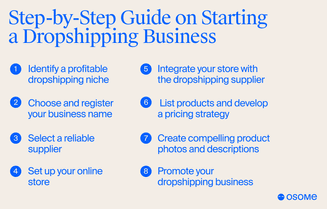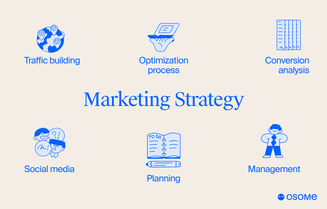What Is Dropshipping and How Does It Work in Hong Kong?
- Modified: 26 December 2024
- 15 min read
- Ecommerce


Gabi Bellairs-Lombard
Author
Gabi creates content that inspires. She's spent her career writing compelling website copy, and now she specialises in product marketing copy. As the voice of our products and features, Gabi makes complex business finance and accounting topics easy to understand. Her top priority is ensuring that her words impact and inspire her readers.
Dropshipping is selling products online without inventory. A supplier ships products to customers when orders are placed. This article explains what dropshipping is, how it works and how to get started.
Key Takeaways
- Dropshipping is a retail fulfilment method in which the store doesn’t hold inventory but transfers customer orders and shipment details to a third-party supplier, who then ships the product to the customer.
- Starting dropshipping in Hong Kong in 2025 involves finding a profitable niche, choosing the right dropshipping supplier, setting up an online store, integrating with supplier apps, setting the right prices, and marketing your products to your target consumers.
- Managing a dropshipping store requires managing your inventory, pricing strategy, impeccable customer service and leveraging various marketing platforms and methods such as SEO, social media and paid advertising to drive traffic and sales.
What Is Dropshipping?
Dropshipping is a simple business model designed to minimize the shop owner's overhead costs. Unlike other business models, dropshipping allows you to start selling with little to no budget with only a few products.
Once a customer purchases a product, you transfer the order and shipping details to your dropshipping supplier, who then ships the product to the customer. This means the retailer never handles the product, making it a great model for those who want to start an ecommerce business without the inventory hassle of a traditional retail business.
For a seamless financial setup, consider using Osome's ecommerce accountants to manage your finances and ensure your business runs smoothly.

One of the biggest advantages of the dropshipping business model is the minimal upfront investment. Entrepreneurs only pay for products when a customer buys, so there is no need to pre-purchase inventory or invest in a warehouse space. This allows businesses to:
- Sell many products without having to stock them
- Buy products from third-party suppliers who deliver
- Focus on marketing and customer service
- Create a smooth customer experience
By dropshipping, ecommerce businesses can make the most of their resources and create a successful online store.
How Does Dropshipping Work?
Dropshipping works like this:
- When a customer orders a product, the dropshipping store forwards the order details and payment to the supplier.
- The supplier prepares the product for shipment.
- The supplier ships the product to the customer.
This seamless process allows the dropshipper to focus on sales and customer service while the supplier handles the logistics.
Many dropshipping stores also use apps like DSers, Zendrop or Spocket to connect the store with a vast network of dropshipping companies while automating order forwarding and inventory management. Suppliers often provide branded invoices and custom packaging to make the dropshipping process efficient and professional. This integration ensures the dropshipping business can run smoothly even with a high volume of orders.
How To Start a Dropshipping Business: Step-by-Step Guide
Starting dropshipping in 2025 involves:
- Find a profitable niche
- Choose a unique business name
- Select reliable dropshipping suppliers
- Set up an online store
- Integrate your store with your suppliers
- List products
- Price your products
Once you have the operational aspects taken care of, it's time to promote your dropshipping business through a well-developed sales strategy, such as multi-channel selling.

1 Find a dropshipping niche
Finding a dropshipping niche is the first step to success. This means specialising in a particular segment based on market research, customer interests, and potential profitability. Tools like Google Trends and Facebook Audience Insights can help you find popular product-related searches, while competitor analysis using Google searches, social media, and online marketplaces can give you an idea of what works.
Check keyword trends and product popularity to ensure your inventory matches customer demand.
2 Choose and register your business name
Choosing the right business name is important for your brand identity. Here are the steps to follow:
- Brainstorm as many ideas as you can.
- Shortlist your top choices.
- Check if your chosen name is available in local jurisdiction databases to ensure no other business is registered with the same name.
- Check if social media handles and domain names are available.
Additionally, consider registering for a Business Registration Certificate (business license) and trademarks for your Hong Kong business name, logo, or unique product features to safeguard your brand and ensure legal protection.
Given the instability generated by working with overseas companies, most entrepreneurs choose to register their business as a limited liability company to offer additional protection to their personal assets.
3 Choose a dropshipping supplier
Choosing a reliable dropshipping supplier is important to minimise issues like late shipments, missing items, packing errors, and product quality issues. Evaluate suppliers based on fast fulfilment time, efficient shipping, positive customer reviews, and order samples for testing.
Before committing to a supplier, ask questions about the dropshipping agreement contract and the costs involved. Ask about their shipping costs for different shipping methods and how reliable they are. Good English and negotiation skills are also important when dealing with international suppliers.
4 Set up your online store
Setting up your online store starts with choosing an ecommerce platform to build your website. Your store should display your product catalogue and have content like product reviews and buying guides to improve the customer experience.
Customised product descriptions with keywords and visuals can improve search rankings and conversions. Customer reviews can build trust, increase conversions and boost SEO rankings.
Check out our PDF guide about basic accounting tips for growing your online store.
5 Integrate your store with the dropshipping supplier
Integrating your store with the dropshipping supplier simplifies product management and order processing. Add a dropshipping app like DSers to your ecommerce store to automate these tasks and connect to a large network of suppliers.
Apps like DSers, Zendrop, and Spocket sync with AliExpress to automate order processing and make the management process much easier. This integration will make your dropshipping process smooth and hassle-free.
6 List products and price your products
Listing products and pricing are important steps to ensure decent profit margins:
- Your retail price should cover the product's wholesale price, shipping fees, and transaction costs to keep dropshipping profitable for you.
- Research competitors to see what pricing structure to use on your specific dropshipping products.
- Know your target audience demographics and buying behaviour to make informed pricing decisions.
Following these steps, you can price competitively and maximise your profit. Try different pricing strategies and adjust according to market trends and customer feedback. Thoroughly refer to your dropshipping contracts to ensure you leave a wide enough margin for yourself to profit.
7 Product photos and descriptions
Creating product photos and descriptions is crucial for attracting customers and conversions. A good product description should:
- Tell a story about what makes the product special
- Persuade the customer to buy
- Use sensory language to make the customer imagine what it’s like to own the product
- Add social proof like customer reviews and testimonials to build trust and credibility.
High-quality product photography and videos can recreate the feeling of touching a product in a physical store and improve the shopping experience.
8 Promote your dropshipping business
Promoting your business to attract and retain customers. Customising product descriptions allows you to stand out from other sellers. You can also use online advertising to compete in the global dropshipping market.
Implement retargeting strategies to recover lost sales by reminding customers of your products' benefits and offering them incentives to buy. You can also leverage social media to build trust, showcase products, and drive traffic to your store. Collaborate with influencers to increase brand awareness and reach new audiences, influencing their buying habits in your favour.
Essential Participants in the Dropshipping Business Model
The dropshipping business model has three main players:
- Retailers: Market and sell products and forward orders to suppliers for fulfilment.
- Suppliers: They store the products, package them and deliver them to customers. Some suppliers may also be manufacturers who produce the products and offer dropshipping services to retailers.
- Customers: They are the end consumers who buy products from online stores.
Knowing the roles of these players is important for smooth operations.
Retailers
A dropshipping business owner benefits from the following:
- Lower startup and operational costs
- No need for a physical warehouse
- No need for a physical warehouse
- Quick to adapt to market changes without inventory risks
Retailers can manage dropshipping remotely, which requires fewer internal resources for warehouse management and fulfilment. All you really need is a good internet connection, some business knowledge, and outstanding customer service skills to boost customer loyalty.
Product manufacturers
Product manufacturers in the dropshipping model:
- Produce the goods
- Often ship them directly to customers based on orders received from retailers
- Help retailers avoid inventory costs so it’s easier for sellers to offer more products
However, quality control is a challenge for manufacturers since retailers don’t physically inspect the products before reaching customers.
Partnering with multiple suppliers can also mean higher shipping costs and logistical complexities since you’re dealing with multiple manufacturers.
Wholesale distributors
Wholesale distributors connect retailers with multiple suppliers. Supplier directories like AliExpress, Worldwide Brands and Doba allow you to browse many dropshipping wholesalers in one place and compare overseas suppliers and trending products. These directories help you find reliable suppliers that meet strict guidelines so you can ensure legitimacy and quality.
SaleHoo and Modalyst offer real-time inventory automation and tracking updates so you can manage your ecommerce sales more easily.
How To Manage Your Dropshipping Business
Building relationships with reliable suppliers helps you to maintain stock levels and minimise the risk of selling out-of-stock products.
When you formulate your pricing strategy, you need to consider all the costs involved, such as product price, ecommerce platform fees, and potential outsourcing costs. Knowing these factors will give you a comprehensive approach to pricing and profitability. Good customer service means responding to customers’ inquiries about shipment, delivery or product quality.

Inventory management
Your inventory is key to dropshipping. Using inventory management apps that integrate with your ecommerce platform and suppliers will help update stock levels and reduce overselling. Diversifying your supplier base minimises the risk of stockouts and gives you more flexibility in pricing and shipping.
Automated inventory workflows can reduce manual errors and save time by forwarding orders to suppliers, updating inventory levels in real-time and sending tracking information to customers.
Pricing strategy
Setting a profit margin involves calculating supplier costs and other operational expenses and considering market prices. Dropshippers make money by buying products from suppliers at a lower price and selling to customers at a higher price so you can make a profit. This business model gives you flexibility in pricing and no need to store inventory. Profit in dropshipping is mostly determined by traffic and average order value, so you need to balance pricing with market trends and customer expectations.
Customer service
Handling customer service well is key to customer trust and satisfaction. Ecommerce customers expect fast shipping. 84% consider shipping as part of their online shopping experience. Dropshippers may face common customer service issues such as:
- Shipment delays
- Delivery problems
- Product defects
- Return requests
Providing accurate product descriptions and clear contact information will enhance customer experience, and prompt response to inquiries will address concerns.
Marketing Strategies for Dropshipping
Good marketing is key to driving traffic and sales to your dropshipping store. Good marketing will increase your store visibility and establish your brand in the competitive ecommerce landscape. Dropshippers often use:
- YouTube
- TikTok
to reach customers.
Engage with niche online communities; email marketing can also increase dropshipping sales.

SEO and content marketing
SEO and content marketing are powerful tools for improving search ranking and organic traffic. Good SEO will increase your store's visibility in search results so customers can find you easily. Using low-competition and high-intent keywords in your content will also improve search ranking.
High-quality and relevant content is loved by search engines and can drive organic traffic to your ecommerce business.
Social media marketing
Social media marketing will build a loyal community and drive traffic to your store. Some of the benefits of social media marketing are:
- Build a loyal community
- Drive traffic to your store
- Increase brand awareness
- Engage with your audience
- Generate leads and sales
Choose platforms that align with your niche and audience so you can tailor your content better. Consistent and valuable content like reviews and tutorials will build a loyal social media community.
Use social media user data to tailor ads to potential customers’ preferences and behaviour, making your marketing more efficient.
Paid advertising
Paid advertising has many benefits:
- Precise targeting and budget adjustment based on performance
- Targeting based on interests and behaviours on platforms like Google Ads and Facebook
- Retargeting ads to recover lost sales by reminding customers of the benefits of your products and offering incentives to complete the purchase.
These are scalable and measurable, so you can adjust your budget based on the performance.
Pros and Cons of Dropshipping
Dropshipping has many benefits, such as low overhead cost and ease of start, but drawbacks, like lower profit margin and reliance on suppliers. Knowing these pros and cons is important for anyone who wants to incorporate dropshipping into their business ventures.
Dropshipping minimises startup risk and gives flexibility but also challenges managing suppliers and building brands.
Benefits of dropshipping
The benefits of dropshipping are minimal upfront investment, flexibility in location and the ability to offer a wide range of products without inventory storage. This model allows entrepreneurs to hold off on product procurement until customers place orders, so it reduces financial risk.
Compared to a traditional ecommerce retailer, a dropshipper can adapt quickly to market changes and customer demand, making them a good option for new business owners.
Challenges of dropshipping
Cons of dropshipping are:
- Limited control over the supply chain
- Challenges in building a brand
- Lower profit margin compared to other business model
- Little to no control over product quality, delivery experience, and package aesthetics can lead to customer dissatisfaction.
Is Dropshipping Legal in Hong Kong?
Yes, dropshipping is legal in Hong Kong. Entrepreneurs can engage in dropshipping activities without legal issues as long as the business complies with relevant regulations and tax laws. However, it's essential to understand and adhere to the legal requirements related to business registration, taxation, and consumer protection laws in Hong Kong.

Business registration and taxes
In Hong Kong, a dropshipping company must register with the appropriate authorities and fulfil tax obligations. Common business structures include sole proprietorships, partnerships, and limited liability companies (LLCs). Each structure offers different levels of liability protection and management structure. Licensing requirements may vary, and dropshippers are typically subject to income tax, sales tax, source tax, and customs/duty tax.
Obtaining a tax exemption certificate can help avoid source tax liabilities in dropshipping.
Compliance and transparency
Maintaining compliance and transparency is crucial for building consumer trust and meeting legal standards. Hong Kong's consumer protection laws mandate transparency regarding product information and shipping times. Violating these laws, such as providing false product information, can result in legal action against dropshippers.
Full disclosure of product origins and adherence to legal standards are essential for establishing consumer trust.
Alternatives to Dropshipping
While dropshipping is a popular ecommerce model, several alternatives still exist. Fulfilment by Amazon (FBA) is when Amazon manages picking, shipping, and customer support. Affiliate marketing promotes other companies’ products and earns a commission on sales without managing inventory or fulfilment.
Private labelling allows you to create branded products, manage your own inventory, and have a unique brand identity.
Fulfilment by Amazon (FBA)
Fulfilment by Amazon (FBA) is an alternative to the dropshipping model where Amazon handles:
- Picking
- Packaging
- Labelling
- Shipping of products
- Customer support services
FBA sellers send their products to Amazon’s warehouses, and Amazon handles storage, packaging and shipping, making the process smooth and efficient.
Amazon FBA also prioritises its sellers’ products and makes them eligible for Prime shipping so they get more visibility and attraction to customers.
Affiliate marketing
In affiliate marketing, the marketer promotes a product and includes a link for customers to buy the product. The marketer earns a commission when the customer uses the referral link to buy, and the supplier handles the following:
- Order confirmation
- Fulfilment
- Shipping
- Returns
Amazon Associates is one of the biggest affiliate marketing programs, and individuals can earn commissions by promoting Amazon products. Affiliate marketing requires:
- Building an audience
- Leveraging existing ones
- Promoting products
- Earning commissions
Private labelling
Private labelling sells products made by another company but branded with your company’s logo and packaging. This allows sellers to create branded products made by others and build brand identity and loyalty.
Private labelling often involves sourcing products from manufacturers, adding your own branding and managing inventory and logistics so you have more control over product quality and customer experience.
Conclusion
Dropshipping allows entrepreneurs to start an ecommerce business with minimal upfront investment and flexible operations. Ask yourself: how does dropshipping work? Once you've fully studied the dropshipping method, you're ready to find your dropshipping suppliers, set up a Shopify store, and sell products to your potential customers.
Be aware of challenges like lower profit margins and reliance on suppliers. Stay compliant with legal standards and explore alternatives like FBA or private labelling, and you can adapt and thrive in the ever-changing ecommerce landscape. Go for the opportunities, navigate the challenges and let your dropshipping journey begin.






